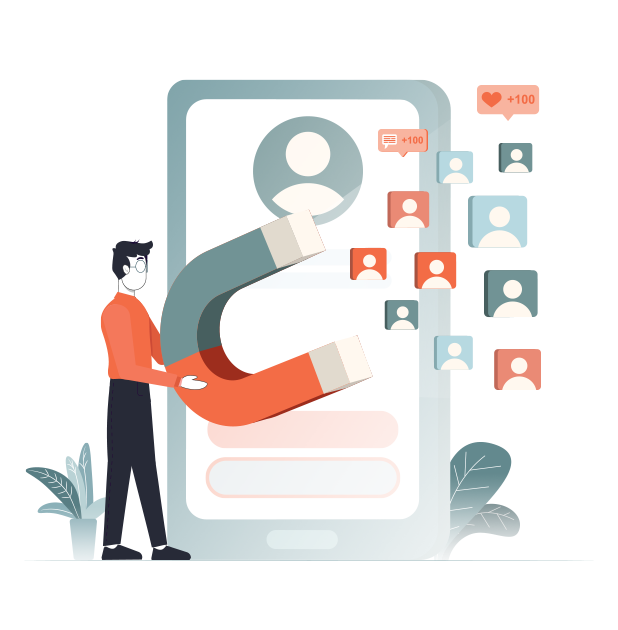Mobile app marketers are challenged to turn first-time users into regulars. The majority of individuals who download mobile apps never use them again. You want your mobile app to be one of the top 3 used by users. You’ll need to increase user engagement in apps and retention by developing a user engagement plan for your mobile app.
How can we get more people to use our app? To increase the number of people using your app, we have developed 15 proven strategies. While some of these guidelines apply to all mobile apps, some are more specific. According to your mobile app’s details, you may measure the efficacy of several methods and put them through their paces to see which ones perform best.
To evaluate the performance of mobile apps, it is crucial to analyze user acquisition characteristics such as user engagement and retention. The two indicators clarify the prominence of a mobile app. The ultimate motivation for developing an app is the promise of a prize of 10,000 app store downloads. The actual test of success is the percentage of former clients again buying your product. Your mobile app can be protected from being replaced by others in several ways.
Given the explosive development in demand for mobile apps, it is crucial to understand the vantage point of the user engagement process if you want to retain your customers and have them use every update of your mobile app. Here you’ll find an in-depth guide on how to make your mobile app more enjoyable to its users.
Why is user engagement important & what is it?
Participation rates are a measure of how well a mobile app is used. This term refers to encouraging prospective customers to return to your app and execute an action that can either directly or indirectly increase your sales and profits. A user’s “engagement” with your shopping or gaming app is the time they spend doing so. Searching your phone will reveal how often you use your preferred app and how quickly you delete apps after a single use. It’s important to remember that installing an app is simply the first step on the road to success. Key performance indicators (KPIs) to consider when evaluating app adoption include:
- The number of active users online.
- The average daily frequency of a given consumer demographic
- Amount of attention from viewers, supporters, critics, and followers.
The success or failure of your app depends entirely on the level of user involvement, which in turn defines how invested your customers remain in the process. One of your duties is to keep your customers apprised of any changes made to the app, to delight them with its new functions, and to encourage them to use it in various ways, such as making purchases, visiting websites, or reading content within.
Also read: UX Design Best Practices 2022: The Ultimate Beginner’s Guide to User Experience
Benefits of using mobile apps
Enhanced customer value
Creating a mobile app is a great way to engage your consumers more frequently. It has the potential to increase market share through enhancing communication with customers. Accessibility rises, and communication with clients is simplified. The more you engage with your customers, the more opportunities you’ll have to offer loyalty programs to encourage them to spend more money with you.
Increases brand value
When your brand is engaged with consumers, it builds trust. It’ll encourage customers to return and conduct business with you. The software simplifies communication and enables users to become loyal consumers. Including mobile app user-specific reward programs and new product launches is an extra hook.
A constant reminder of your business
Your target demographic checks their phones countless times a day. A mobile app for smartphones and tablets allows customers to engage with your company in ways they might not even be aware of. The applications can do more for your brand’s exposure and communication than any browser. The finest brand experiences may also boost in-app purchase conversions.
Find out more: Top Reasons How Mobile Apps will Boost the Hospitality Industry
Methods to increase app usage and satisfaction
1. Simple onboarding procedure
First, consider this as you attempt to make your app attractive to consumers. Users are likelier to continue using an app with a smooth and individualized onboarding process. Tips for an easy onboarding process are provided below.
- If you need to create an account, do so with as little information as possible.
- Add several sign-in options (email, Google, and Facebook).
- Ensure users stay energized while highlighting the app’s best features.
2. Adapt the onboarding process for a new user
To personalize the welcome message for each user, you can use the information they provided during signup or registration to tailor emails and web pages.
3. App store visuals
Downloads, ratings, and reviews may all be monitored after an app has been optimized for the app store. A well-optimized app title, icon, images, videos, and description may all help draw in consumers and convince them to download and try out your app.
4. Use personalized messages
Personalization is essential to keep users engaged within mobile apps, just as it is in all other consumer touchpoints. However, the few applications that use personalized messaging merely advise products. The user experience may be improved by providing a personalized greeting and landing page. Use of customer information is permitted so long as the intended use is made clear.
You may communicate with mobile app users via in-app messaging if you have gathered enough information about them. However, sending too many messages might negatively impact the user experience, so be careful. Businesses may learn more about users’ exit points and other behavior by analyzing records of user sessions on mobile devices or by using touch heatmaps.
5. Push notifications
Push notifications are a simple way to get more people involved with your software. Push notifications are a great option when looking for a way to get people to interact with your mobile app. Users can use it to inform one another about new software features or to distribute helpful how-tos. Users may be annoyed, but companies may compensate for it with more personalized interactions.
App retention may be increased by three to ten with individualized push notifications. According to MoEngage, Adding call-to-action buttons to the messages is a good idea. Taking the use of local reports and custom actions is possible. Use users’ names in communications, and divide them into groups according to their characteristics.
6. Account creation and sign-up process
You should include a registration form in your app’s onboarding process to learn more about your users’ behavior and communicate with your target audience. The primary purpose of registration is to swiftly and efficiently collect users’ contact information.
7. Use quick actions on the home screen
Companies should focus on keeping consumers on the mobile app’s main screen. The app’s Quick Actions sections provide users with a streamlined interface for navigating the rest of the app. The user is not required to touch on the specific portion to read the messages.
Designers of mobile app user interfaces should consider this option to increase user retention. They have a firm grasp of UX design fundamentals, such as Quick Actions and Deep Linking. Professional UX designers can be hired to add this functionality.
8. Using emails knowledgeably
One other way to increase mobile app retention is through email. Update your users about the latest app changes and sales by emailing them. New users may learn what they need to do to get started with some help from a welcome email. A relationship with a new user can get off to a great start with one of these emails.
The app’s users’ actions may be monitored, and the data used to send them emails describing the app’s newest functions. You can predict which users are likely to leave by analyzing their actions. Improve your customers’ experiences by sending them helpful emails that contain relevant information and reasonable offers. Emails from a business-to-business app should be sent with the recipient’s job in mind.
9. Freemium model
Many new users may need to try your app for free before paying for the full version. Offering limited free features within a mobile app is a simple method to boost purchases.
10. Widgets
Widgets are a great way to provide users with current, tailored content from your app. Simply put, they are a snapshot of the most critical aspects of your mobile app. Widgets may be dragged and dropped between panels on the home screen and resized to fit the user’s desired amount of content. With widgets, your customers may access key stats without launching your app, boosting retention and usability. An app widget may be made in three simple steps:
- First, zero in on who you want to reach with your widget by considering the core principles that underpin your mobile app. You may enhance the usefulness of your device by including media like deep links, videos, and images.
- The second stage entails developing a test version of your widget. It will demonstrate how your device will appear in various circumstances (on another platform, with a dark theme, in a different size, etc.)
- In Stage 3, you’ll establish a routine for the widget’s updates and make choices about the content and times it will appear.
11. Upgrade the UI regularly
The mobile app needs to develop over time, putting plenty of effort into the user interface and experience. The same user interface (UI) used repeatedly might become old for your users. Improving the mobile app’s user interface and understanding in response to feedback from existing users is one way to boost retention.
You may learn more about how your users engage with your app with analytics tools. User surveys can elicit valuable information about what users want to see improved in the app’s UI and procedures. With A/B testing, your team can determine your software’s most efficient methods and techniques.
12. Multi-channel engagement
In your opinion, can retention rates be increased only through app-based communication with users? Instead of only using one method to contact your consumers, why not try a few other techniques? Involve the audience by using various internet media (which are also less expensive) and engaging with them. It may also aid in expanding your app’s user base.
The mobile site may showcase the app’s journey by providing a direct link to the relevant page within the app. Your app may also use deep links from other social networking platforms. It can increase user engagement while decreasing ad costs.
13. Make your app accessible to the disabled
It’s a win-win if you can make your app accessible to individuals with disabilities since that will boost your user base, encourage more people to use it, and bring in more money. Use these guidelines to make your app usable by people with a wide range of impairments:
- Impairment of sight: To accommodate users who are blind or have low vision, install a screen reader. Make use of screen enlargement and voice feedback software.
- Problems hearing: Include transcriptions or subtitles in your movies and apps for people who have hearing impairments. Whether it’s for incoming calls, app notifications, or vibrations, you can set up alerts for any of these scenarios.
- Difficulties in navigating: Create shortcuts for often-used terms and increase the time between taps on your app displays. The user should customize the size of buttons and other interface elements.
- Insufficient literacy skills: An essential UX with short, straightforward language and easily identifiable symbols and graphical components can help you reach users with a low level of literacy. Integrate voice comments as well.
Dig deeper: Top 11 Emerging App Ideas, Development Cost, and Market Size for 2023 [Infographic]
14. Focus on the fast performance of the mobile application
An important aspect of user retention is the app’s loading time. When searching within your app, the user will find it frustrating and time-consuming if it takes too long. As a result, rapid application loading should be a top priority during development. Here are a few suggestions for enhancing the app’s features:
- The image’s proportions may be better.
- Avoid overusing bullet points and links in this area.
- Accuracy is essential while writing.
15. Social media
Using social media to boost participation in mobile apps is a common practice these days. Successfully advertising your app on social media requires understanding the nuances between the various platforms. The adoption and usage of your mobile app on a worldwide scale may be accelerated by utilizing the power of social media to increase conversions and retention, decrease churn, and strengthen customer loyalty.
Deep dive: How Do Mobile Apps Make Money & Monetization Models
Conclusion
In conclusion, increasing user engagement in apps is crucial for the success of any app. There are many ways to boost user engagement, from creating a seamless user experience to implementing effective marketing strategies. A software development company like NeoITO can help you improve user engagement by providing guidance and expertise in app development and support with design, testing, and deployment. NeoITO also offers ongoing maintenance and updates, as well as performance monitoring and analytics services, which will help you understand how users engage with your app and make data-driven decisions to improve it. By following the tips outlined in this guide and working with NeoITO, you can increase user engagement and drive success for your app.
FAQs
Why is user engagement important for an app?
User engagement is essential for an app because it helps to keep users interested in the app and more likely to return and use it regularly. This can lead to increased revenue and a higher retention rate.
What are some ways to increase user engagement in apps?
Some ways to increase app engagement include creating a seamless user experience, implementing effective marketing strategies, and providing valuable and relevant content.
How can a software development company like NeoITO help increase user engagement in an app?
NeoITO can help increase user engagement in an app by providing guidance and expertise in app development, as well as support with design, testing, and deployment.
NeoITO also offers ongoing maintenance and updates, as well as performance monitoring and analytics services, which will help you understand how users engage with your app and make data-driven decisions to improve it.
How do you measure user engagement in an app?
User engagement in an app can be measured through metrics such as active users, retention rate, and session length.
How can I keep users interested in my app?
Keep users interested in your app by regularly updating the app with new features, providing valuable and relevant content, and implementing effective marketing strategies.




